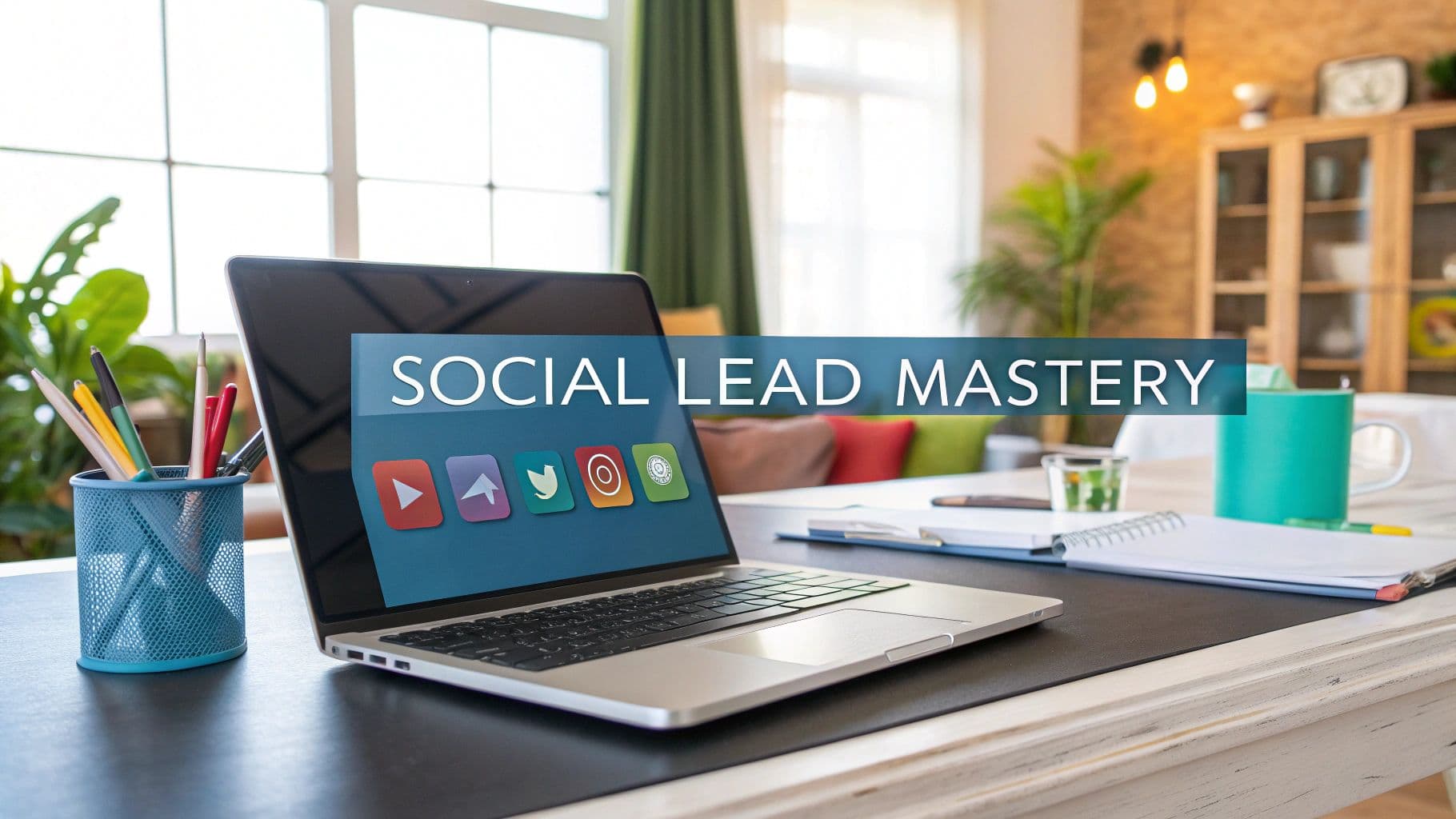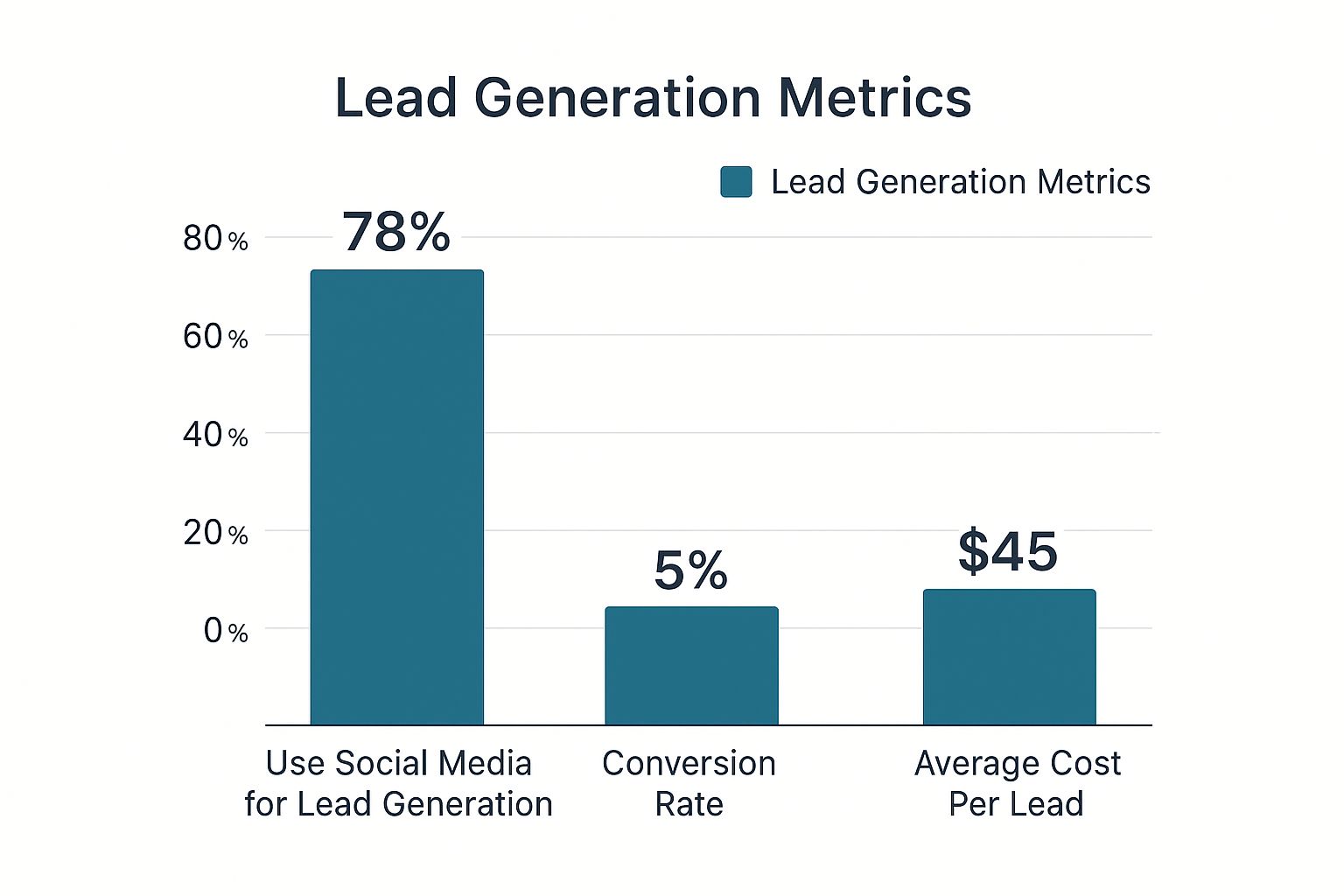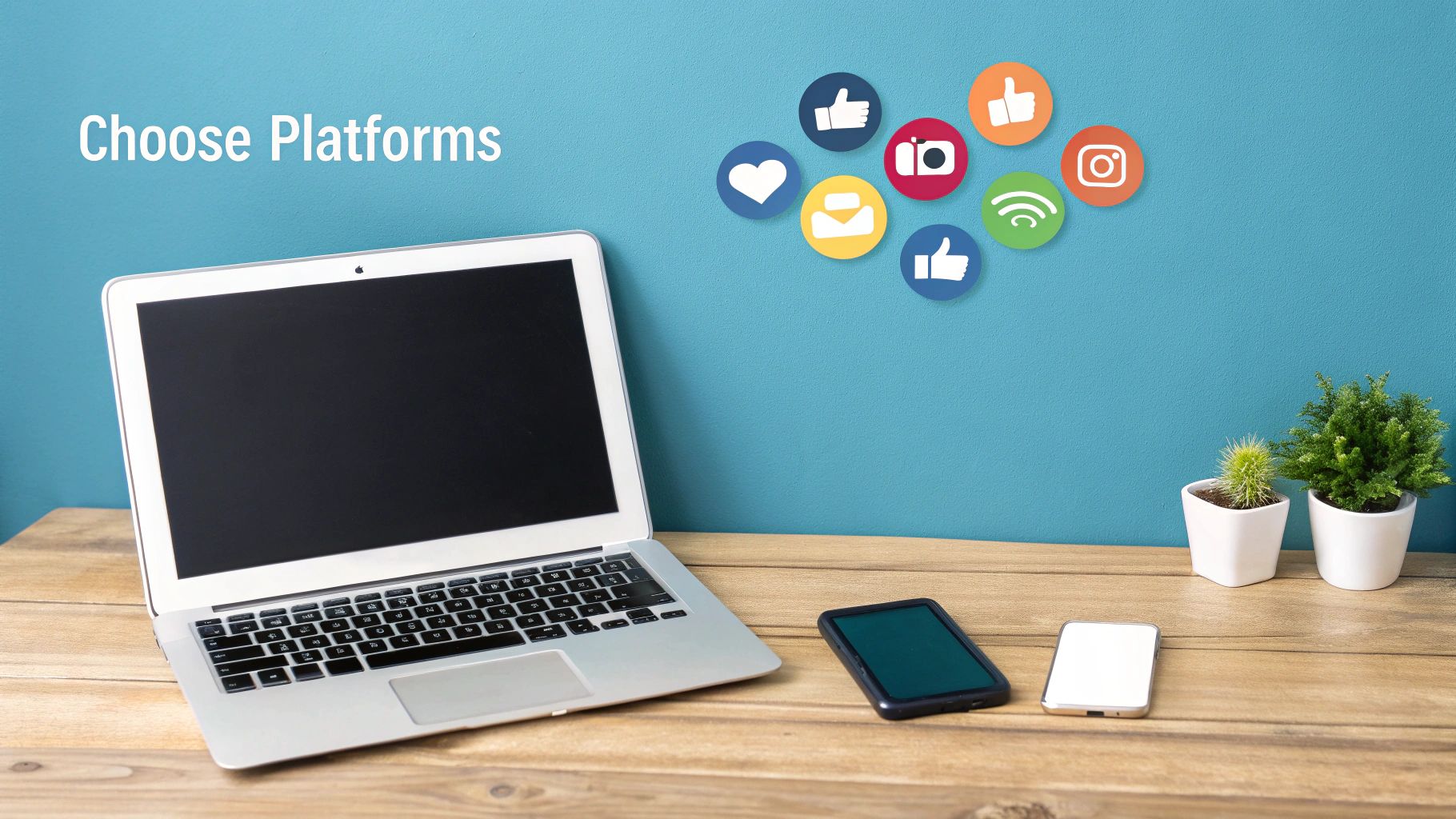
Forget shouting your sales pitch into a crowded room. At BillyBuzz, lead generation from social media means joining conversations where customers are already talking about their problems. It’s about finding high-intent discussions, not just broadcasting into the void.
Building a Social Lead Generation Machine
Forget the generic advice about posting three times a day. Our playbook is simpler: go where your customers are and genuinely add value. It's not about being the loudest voice; it's about being the most helpful one.
We ignore vanity metrics and don't try to be active on every trendy platform. Instead, we zero in on digital "watering holes"—those niche online spaces where high-intent prospects gather to ask for advice, vent their frustrations, and look for solutions. This approach flips the script entirely, shifting us from broadcasting a marketing message to becoming a valued participant in an ongoing dialogue.
Choosing The Right Battleground
The first thing we do is ruthlessly prioritize which platforms deserve our attention. We don't have the time or resources to be everywhere. Our internal checklist cuts through the noise and pinpoints the channels that deliver actual prospects, not just passive followers.
Here’s how we validate a platform before we commit any time:
- Problem-Solution Fit: We start by searching for keywords related to our customers' pain points—not our brand name. Are people actively discussing the exact problems our product solves?
- Conversation Quality: Is the engagement substantive and solution-focused, or is it all just surface-level noise and self-promotion? We're looking for communities where people ask real questions and get detailed, thoughtful answers.
- Accessibility: How easy is it to jump into a conversation without being immediately flagged as a spammer? We prioritize platforms with community rules that encourage helpful contributions.
This methodical process ensures every minute we spend is directly tied to building our pipeline. If you're looking to fast-track your skills, an intensive lead generation boot camp can be a great way to accelerate your learning.
At BillyBuzz, our strategy is very focused. Here's a look at how we break down our platform priorities:
BillyBuzz's Platform Focus for Lead Generation
| Platform | Lead Type | Primary Activity |
|---|---|---|
| B2B Decision-Makers | Thought leadership, direct outreach, group discussions | |
| Twitter (X) | Tech & Startup Founders | Real-time conversation monitoring, sharing insights |
| Niche B2B/B2C Users | Answering questions in subreddits, problem-solving | |
| Facebook Groups | Specific Interest Groups | Providing value in niche communities, building trust |
This table shows our deliberate choice to focus our main efforts where we know our ideal customers are actively looking for help.
Tracking The Right Initial Metrics
Before we go all-in on a new channel, we track a handful of key metrics to see if it's actually worth our time. I'm not talking about likes or shares. We only care about signals that point to real business opportunities. We’ve found ways to automate a lot of this discovery work; you can see exactly how we do it in our guide on how to find leads on social media with AI.
This chart gives you a good look at some of the industry benchmarks for social media lead generation.

The data really drives the point home: lots of businesses are using social media, but the ones who win are those who manage their costs and conversion rates effectively to see a real return.
The efficiency here is undeniable. Recent reports show that 66% of marketers generated leads from social media by dedicating only about six hours per week. This isn't about outworking everyone; it's about working smarter. With a focused strategy, precise targeting, and truly valuable content, you can generate a steady stream of high-quality leads without it becoming a massive time sink.
Our LinkedIn Playbook for High-Value B2B Leads

When it comes to B2B growth, LinkedIn is our engine. But we've ditched the spammy, automated outreach that clogs up everyone's inbox. Our approach is all about turning LinkedIn into a reliable source of qualified conversations.
It starts with our profiles. We treat them less like resumes and more like sales pages. Every line—from the headline to the summary—is crafted to speak directly to the pain points of our ideal clients. It's a founder-to-founder conversation that shows them we get their world and have a solution.
Engaging in Niche Industry Groups
Once our profiles are dialed in, we go where the real talk is happening: niche industry groups. You’ll never see us just dropping links or posting self-promotional fluff. The entire goal is to become a recognized, helpful voice by adding genuine value to conversations already in progress.
We sniff out the groups where our ideal customers are hanging out, asking for advice, and sharing their biggest headaches. By consistently offering thoughtful answers and useful insights, we build trust and authority. This groundwork makes our eventual outreach feel natural and welcome.
Our rule is simple: for every one 'ask,' we provide ten 'gives.' Whether it's sharing a resource, offering a quick tip, or making an introduction, we focus on being helpful first. The leads follow naturally.
For any business serious about landing high-value B2B clients on LinkedIn, building out a winning B2B social media strategy is non-negotiable. A clear plan ensures every move you make, from optimizing your profile to engaging in groups, directly feeds your sales pipeline.
The data absolutely supports this focused strategy. Research shows that 40% of B2B marketers see LinkedIn as their top channel for high-quality leads. And its Lead Gen Forms? They have an incredible 13% conversion rate, blowing the average landing page conversion of 2.35% out of the water. This just goes to show what’s possible when you use the platform correctly.
Hyper-Targeting with Sales Navigator
This is where we get surgical. Sales Navigator is our secret weapon for cutting through the noise. Here’s the exact filter combination we use inside BillyBuzz:
- Keywords: We look for specific job titles like "Head of Growth" or "Marketing Manager."
- Company Headcount: Our sweet spot is companies with 11-50 employees, so we filter for that range.
- Geography: We focus on regions where we already have a strong foothold.
- Posted on LinkedIn in past 30 days: This is our non-negotiable filter. It guarantees we’re only talking to people who are active on the platform, which has a massive impact on our response rates.
This level of precision means we’re not wasting a single minute on irrelevant prospects.
The Art of the Non-Salesy Outreach
With our list ready, we start the outreach. But we never send a generic pitch. Our connection requests and follow-ups are designed to do one thing: start a real conversation.
Our Proven Connection Request Template
This simple message gets a ton of acceptances because it's personal and doesn't ask for anything.
Hi [First Name],
Saw your post on [specific topic]. Liked your point about [add brief, genuine comment].
I'm also focused on startup growth and connecting with like-minded folks.
The follow-up sequence is just as subtle. We continue the conversation, ask thoughtful questions, and only suggest a call when it becomes obvious there's a problem we can actually help solve. It’s a patient, value-first method that consistently books discovery calls without ever feeling like a hard sell.
Finding Hidden Leads in Niche Online Communities
While your competitors are spending a fortune on LinkedIn, some of our highest-intent leads are hiding in plain sight on Reddit and specialized forums. These platforms are absolute goldmines.
The key is that people in these communities aren't looking for a sales pitch. They're looking for solutions. Our entire strategy is built on being a problem-solver first and a vendor second.
Pinpointing High-Intent Conversations
Forget manually scrolling through forums. We use BillyBuzz to monitor these communities for conversations that signal a real need. Here are the exact subreddits we monitor daily:
- r/smallbusiness: A hub for entrepreneurs discussing everything from marketing to operations.
- r/sysadmin: A technical community where IT professionals discuss software and system management challenges.
- r/SaaS: A gathering place for SaaS founders to share growth strategies and tool recommendations.
Monitoring these communities is where the real work begins. Our actual alert setup inside BillyBuzz tracks phrases like "how to find customers," "tired of manual prospecting," or "best way to monitor Reddit." This immediately surfaces conversations where people are actively looking for a solution we provide.
Here's a look at the r/smallbusiness subreddit, a prime example of a community where genuine business challenges are discussed openly.
This snapshot shows real-time discussions where founders are asking for advice on marketing, sales, and operational hurdles—precisely the conversations we want to join.
Engaging Without Getting Banned
The etiquette on these platforms is everything. Communities like Reddit have a low tolerance for self-promotion. The goal is to build credibility (karma on Reddit) by consistently offering value before you ever hint at your product.
Our response framework is simple but strict.
- Acknowledge and Validate: Start with, "I've been in that exact situation, and it's tough."
- Provide Genuine Value: Offer a direct solution or piece of advice that helps them immediately, without mentioning your product. This could be a framework, a tip, or a link to a helpful third-party resource.
- Subtly Introduce Your Experience: If it feels natural, you can mention your experience. For example, "In my experience building a tool for this, I've found that..." This establishes your authority without being a direct sales pitch.
The ultimate goal is to be so helpful in the public thread that the original poster (or someone else reading it) decides to send you a private message. We never initiate the private conversation ourselves. This patience is critical for success.
This method requires a deep understanding of the platform's culture. For those looking to master this approach, our guide on how to get customers from Reddit in 2025 breaks down the entire process from building karma to crafting the perfect value-first comment.
The Art of the Private Conversation
Once a user moves the conversation to a direct message (DM), the dynamic changes. This is where you can gently introduce your product.
Here’s our go-to DM response template:
"Hey [Username], happy to help.
Based on your thread about [restate their pain point], it sounds like you're struggling with [diagnose the core problem].
We actually built a tool specifically to solve that by [explain 1-2 key benefits]. No pressure at all, but if you're curious, I can share a bit more. Either way, hope the advice from the thread helps!"
This response is low-pressure, references their specific problem, and puts the ball back in their court. It's this respectful, helpful approach that turns a simple community interaction into a warm, qualified lead.
Using Social Proof to Build Trust and Warm Leads
You can't sell to someone who doesn't trust you. Before we even think about sending a message, our goal is to build undeniable credibility. We do that by weaving social proof into everything.

Telling people your product works is one thing. Showing them is another. We let our happy clients do the heavy lifting by turning their wins into our most persuasive marketing assets. This isn't just a one-off tactic; it's about integrating real-world proof everywhere.
Partnering with Micro-Influencers for Authentic Testimonials
Forget big-name celebrity endorsements. The most powerful voices come from micro-influencers who are genuine users of our product. Their word is real and relatable.
Finding them isn't complicated. We keep an eye on social media for power users who are already talking about our tool. When we spot a great fit, we don't just ask for a shoutout. We focus on building a real partnership.
This usually looks something like this:
- Hooking them up with a free premium account for life.
- Giving them early access to our newest features.
- Featuring their work and expertise on our own channels.
What we get in return is pure gold: authentic, unscripted testimonials and video clips. We then repurpose this content across all our channels, creating a library of credible proof that warms up potential leads before we’ve even said hello.
Encouraging and Amplifying User-Generated Content
User-generated content (UGC) is the ultimate stamp of approval. It’s an unsolicited endorsement from a real customer, and frankly, it's more powerful than anything our marketing team could create. Our whole approach to getting more UGC is built on one idea: make it easy and rewarding for clients to share their success.
We've learned to prompt customers for feedback at just the right moment—like right after they've found a great lead using our tool. A simple email asking them to share their win on Twitter or LinkedIn and tag us can work wonders. We also run small monthly contests, offering gift cards or account credits for the best UGC.
The secret is to remove every ounce of friction. We give them simple prompts and make sharing a one-click process. And when a customer tags us in a success story, we don’t just hit ‘like’ and move on. We amplify it. We reshare it, comment on it, and stick it right at the top of our profiles.
This isn't just a nice-to-have; it's a core part of our growth. The data speaks for itself. Social networks were projected to account for 17.11% of all online sales in 2025, and UGC influences a staggering 90% of shopper buying choices. It's a loud and clear signal that genuine user stories are what really persuade people. You can find more insights on social commerce and UGC's impact in recent industry analyses.
Transforming One Success Story into a Dozen Assets
A single great client win isn't just one piece of content—it's a goldmine. We have a simple internal playbook for "atomizing" a success story, turning it into a dozen or more short-form videos and other assets. This lets us squeeze every drop of value out of each positive result.
Here’s a peek at how we break down a single client testimonial:
- The Full Interview: It all starts with a 15-minute video call where we let the client talk about their challenges and how they got results.
- The Highlight Reel: We’ll edit that down into a punchy 2-3 minute case study video for our website and YouTube channel.
- Short-Form Clips: From there, we pull out 5-7 of the most powerful quotes or data points and turn each one into a 15-30 second Reel or Short. Each clip zeroes in on a single pain point or benefit.
- Quote Graphics: The best soundbites get turned into sharp-looking graphics for Instagram, LinkedIn, and Twitter.
- The Written Word: We transcribe the key parts of the interview to use as testimonials on landing pages and in our email newsletters.
This system keeps our content pipeline full of fresh, compelling social proof. Those short, snappy videos are especially effective for bringing in new inquiries, showing potential leads exactly what we can do for them before we ever have to make a sales pitch.
Turning Social Conversations into Sales Opportunities
Spotting a potential lead is just the first domino. The real magic is turning that casual social media chat into a real sales conversation—without sounding like a typical pushy salesperson. It all comes down to a smooth handoff.

It’s about knowing the perfect moment to guide someone from a public thread or a DM into a more focused channel, like an email or a discovery call. Fumble this transition, and you can kill a warm lead instantly. But get it right, and the next step feels like a natural progression.
Knowing When to Make the Move
The single biggest mistake I see founders make is jumping the gun. They try to pull the conversation offline way too early. You have to earn the right to ask for their time.
We have a simple rule for this: the three-touch rule. Before we even think about suggesting a call, we make sure we've had at least three meaningful, value-first interactions.
A "touch" could be:
- Answering their question thoughtfully in a public thread.
- Following up in a DM with a genuinely useful resource.
- Offering a quick, personalized tip based on something you saw on their profile.
Once you’ve established that you're there to help, they start to see you as a credible expert, which makes them far more receptive to a deeper conversation. We dig into finding these high-intent discussions in our guide on social listening for B2B lead generation.
The Seamless Transition Template
When it’s time to suggest a call, the words you choose are everything. We strictly avoid corporate jargon. The goal is to be direct but incredibly low-pressure.
Here’s a DM template we use internally after we've built trust:
"Hey [First Name], enjoyed our chat about [their challenge]. Based on what you've mentioned, I have a few specific ideas on how you could [achieve desired outcome], but they're too much to type out.
No pressure, but if you're open to it, I'd be happy to hop on a quick 15-minute call to walk you through them. Let me know if that sounds helpful!"
Why does this work so well? It directly references your previous conversation, making it feel personal, and frames the call as a value-add, not a sales ambush.
Tracking and Scoring Leads
A conversation you don't track is a lead that's destined to fall through the cracks. A simple pipeline in Trello or Notion works perfectly. Just create a card for each prospect and move them through stages like "Initial Contact," "Conversation Started," "Call Booked," and "Follow-up."
To make sure we're focusing our energy where it counts, we use a dead-simple lead scoring system based on their engagement.
| Score | Criteria | Action |
|---|---|---|
| 3 (Hot) | Proactively reached out via DM; explicitly mentioned a pressing pain point we solve. | Top priority. Aim to book a call within 24 hours. |
| 2 (Warm) | Engaged with our value-add comment; asked a follow-up question. | Nurture with one or two more helpful touches before suggesting a call. |
| 1 (Cool) | Passively liked a comment or followed our account. | Keep an eye on their activity. Engage if a more direct opportunity pops up. |
This simple framework keeps us from chasing cold leads and ensures our time is spent on the people who have shown the clearest intent.
Handling Objections and Disengaging Gracefully
Look, not every chat will blossom into a sale. And that's okay. The key is knowing how to handle objections and, just as important, when to walk away.
If a prospect says "not the right time," we thank them for their honesty and offer to stay in touch as a helpful resource. Simple.
Likewise, if it becomes obvious they aren't a good fit, we disengage gracefully. "Thanks for sharing more about your process. Based on that, I honestly don't think we're the right solution for you right now, but I wish you the best of luck!" is professional and keeps the door open for the future. That kind of founder-to-founder honesty builds far more long-term trust than any pushy sales tactic ever could.
Key Questions on Social Media Lead Generation
As founders, we get asked the same questions over and over. Forget the textbook answers. Here's our straight-up advice based on what we've seen work firsthand while building the BillyBuzz pipeline.
Which Social Media Platform Is Best for B2B Leads?
Everyone knows LinkedIn is the king for most B2B industries. But thinking it's the only option is a massive mistake. It's also where every one of your competitors is.
The real hidden gems are tucked away in niche communities. We've found incredibly high-intent leads on platforms like Reddit or in super-specific industry forums. People in these spaces are actively asking for help, which means you face far less noise and get to engage with prospects who are already problem-aware.
A lead from a niche Reddit community is often warmer than a cold outreach on LinkedIn. They're seeking a solution, not just browsing a feed, which makes the initial conversation much more direct and productive.
How Do You Measure Social Media Lead Generation ROI?
Measuring your return has to go way beyond vanity metrics. Likes and shares don't pay the bills. To understand ROI, you have to track the entire journey from that first social media touchpoint to a closed deal.
At BillyBuzz, we obsess over a few core metrics that paint a clear financial picture.
- Cost Per Lead (CPL) by Channel: We calculate exactly how much it costs to acquire a single lead from LinkedIn, Reddit, or anywhere else. This tells us where our money and time are getting the best bang for the buck.
- Lead-to-Meeting Conversion Rate: Of all the leads we generate, how many actually turn into a scheduled sales call? This metric is our gut check on the quality of leads from each platform.
- Customer Lifetime Value (LTV): This is the ultimate metric. We track the total LTV of clients who came from social media to see which channels consistently bring in the most valuable, long-term customers.
Tracking these numbers gives us an undeniable picture of what's working, so we can double down on our most profitable activities.
What’s a Realistic Timeframe to See Results?
This is the classic "it depends" question, but here’s a founder-to-founder breakdown. The timeline hinges entirely on your strategy.
If you’re running a targeted outreach campaign, like our LinkedIn playbook, you can see initial results almost immediately. It's realistic to start booking meetings within the first few weeks. It's the fastest path to having actual conversations.
On the other hand, building a brand through content and community engagement is a long game. This inbound strategy is all about consistently providing value and building authority. It often takes 3-6 months to build enough momentum to generate a consistent, predictable flow of inbound leads.
Should I Use Automation Tools for Outreach?
Our philosophy on automation is simple: use it to assist, never to replace. We use tools strategically to help us identify potential prospects and monitor for keywords—this saves a massive amount of manual work. But we have a hard and fast rule: never automate the initial outreach message.
In a world flooded with generic, robotic DMs, personalization is your single greatest advantage. A message that shows you've done even 30 seconds of research on the person you're contacting will outperform a hundred automated blasts every single time. Genuine connections are what lead to high-value deals.
Ready to stop scrolling and start converting? BillyBuzz uses AI to monitor Reddit for you, sending real-time alerts when potential customers are discussing problems you can solve. Find hidden leads and join high-intent conversations before your competitors even know they're happening. Start your free trial at BillyBuzz.
